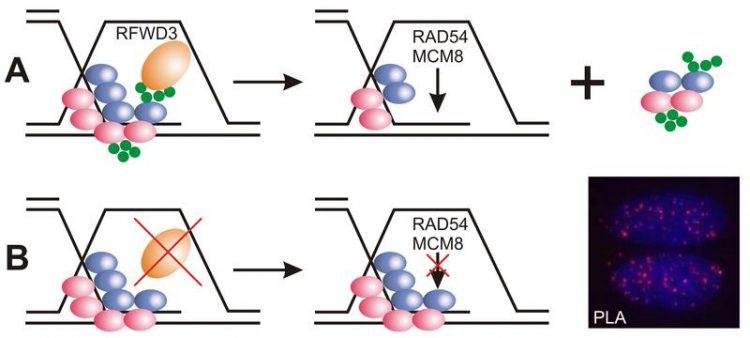New gene mutation associated with Fanconi anemia

A: The enzyme RFWD3 helps target other proteins on single-stranded DNA for degradation. B: Cells lacking RFWD3 show DNA repair defects. (Figure modified from Inano et al.)
Fanconi anemia is a rare genetic disease characterized by bone marrow failure heralded by low platelet counts and unusually large red blood cells. Mutations in over 20 genes have been identified as causative for Fanconi anemia, which encode proteins commonly involved in DNA repair mechanisms.
The failure to repair DNA is considered the source of increased cancer risk in individuals with Fanconi anemia. Ongoing efforts to identify additional genes and pathways linked to this disease may concurrently reveal potential susceptibility genes for hereditary cancers.
This week in the Journal of Clinical Investigation (JCI), a team led by Detlev Schindler at the Julius-Maximilians-Universität (JMU) Würzburg in Bavaria, Germany, reports classical Fanconi anemia symptoms in a 12-year-old individual without mutations in any of the known Fanconi anemia genes.
Mutations detected
Sequencing of this individual’s genome detected mutations in both alleles of the gene RFWD3, which encodes an enzyme that helps target other proteins on single-stranded DNA for degradation. This process is impaired in patient’s cells which rendered them more sensitive to chromosome breakage and DNA damage, compared to cells from healthy individuals.
Other cells either lacking RFWD3 or genetically engineered with the patient’s missense mutation showed similar DNA repair defects, which were rescued by expression of wild-type RFWD3. Moreover, RFWD3-deficient mice exhibited a phenotype that resembles other mouse models of Fanconi anemia. Together, these findings support the identification of RFWD3 as a Fanconi anemia gene.
„Biallelic mutations in the ubiquitin ligase RFWD3 cause Fanconi anemia“, Kerstin Knies, Shojiro Inano, María J. Ramírez, Masamichi Ishiai, Jordi Surrallés, Minoru Takata, and Detlev Schindler. Journal of Clinical Investigation, 10. July 2017, DOI: 10.1172/JCI92069
Schindler and collaborators further describe the mechanisms by which RFWD3 mediates DNA repair in two accompanying studies recently published in Molecular Cell. Future explorations of this enzyme may reveal its importance as a therapeutic target in certain subtypes of Fanconi anemia or cancer.
Contact
Prof. Dr. Detlev Schindler, Institute of Human Genetics, University of Würzburg, Germany, T +49 931 31-88075, schindler@biozentrum.uni-wuerzburg.de
http://www.jci.org/articles/view/92069 Publication in the Journal of Clinical Investigation
https://doi.org/10.1016/j.molcel.2017.04.022 Publication 1 in „Molecular Cell“
http://dx.doi.org/10.1016/j.molcel.2017.04.021 Publication 2 in „Molecular Cell“
Media Contact
All latest news from the category: Life Sciences and Chemistry
Articles and reports from the Life Sciences and chemistry area deal with applied and basic research into modern biology, chemistry and human medicine.
Valuable information can be found on a range of life sciences fields including bacteriology, biochemistry, bionics, bioinformatics, biophysics, biotechnology, genetics, geobotany, human biology, marine biology, microbiology, molecular biology, cellular biology, zoology, bioinorganic chemistry, microchemistry and environmental chemistry.
Newest articles

A universal framework for spatial biology
SpatialData is a freely accessible tool to unify and integrate data from different omics technologies accounting for spatial information, which can provide holistic insights into health and disease. Biological processes…

How complex biological processes arise
A $20 million grant from the U.S. National Science Foundation (NSF) will support the establishment and operation of the National Synthesis Center for Emergence in the Molecular and Cellular Sciences (NCEMS) at…

Airborne single-photon lidar system achieves high-resolution 3D imaging
Compact, low-power system opens doors for photon-efficient drone and satellite-based environmental monitoring and mapping. Researchers have developed a compact and lightweight single-photon airborne lidar system that can acquire high-resolution 3D…





















